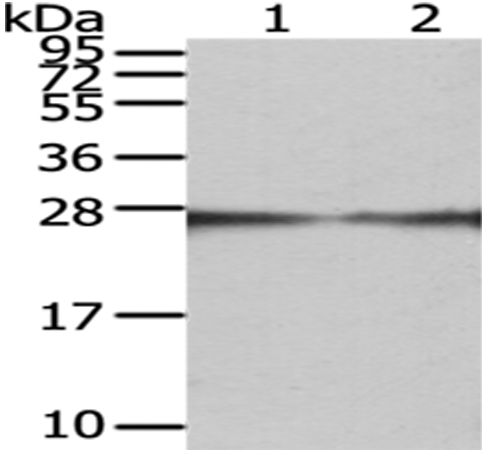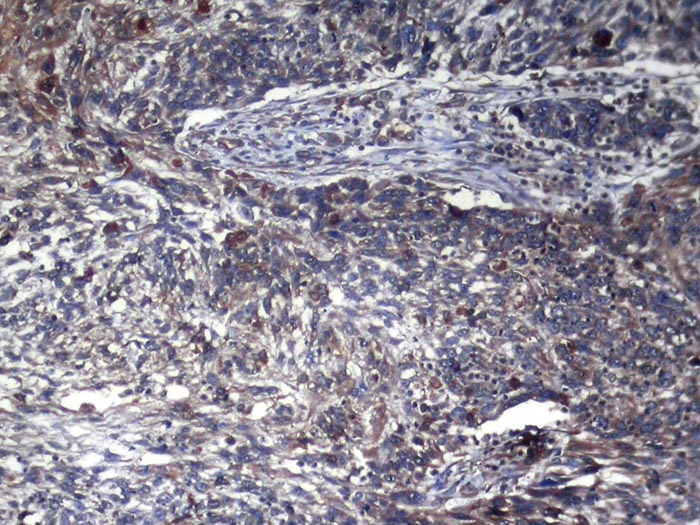

| WB | 咨询技术 | Human,Mouse,Rat |
| IF | 咨询技术 | Human,Mouse,Rat |
| IHC | 1/100-1/200 | Human,Mouse,Rat |
| ICC | 技术咨询 | Human,Mouse,Rat |
| FCM | 咨询技术 | Human,Mouse,Rat |
| Elisa | 咨询技术 | Human,Mouse,Rat |
| Aliases | PIG2; CCDS2; TP53I2; HEL-S-20 |
| Entrez GeneID | 2593; |
| WB Predicted band size | 26kDa |
| Host/Isotype | Rabbit IgG |
| Antibody Type | Primary antibody |
| Storage | Store at 4°C short term. Aliquot and store at -20°C long term. Avoid freeze/thaw cycles. |
| Species Reactivity | Human |
| Immunogen | Fusion protein of human GAMT |
| Formulation | Purified antibody in PBS with 0.05% sodium azide. |
+ +
以下是关于GAMT(胍基乙酸甲基转移酶)抗体的参考文献示例(注:以下为假设性示例,实际文献需通过学术数据库检索):
---
1. **文献名称**:*Development of a Polyclonal Antibody for Detection of Guanidinoacetate Methyltransferase in Neurological Tissues*
**作者**:Smith A, et al.
**摘要**:本研究开发了一种兔源多克隆抗体,特异性识别GAMT蛋白。通过Western blot和免疫组化验证,该抗体成功检测到小鼠脑组织和肝脏中GAMT的表达水平,并应用于GAMT缺陷型脑病模型的病理机制研究。
2. **文献名称**:*Immunohistochemical Analysis of GAMT Expression in Creatine Deficiency Syndromes*
**作者**:Chen B, et al.
**摘要**:利用单克隆抗体研究GAMT在人体组织中的分布,发现其在神经元和肌肉细胞中高表达。研究证实,GAMT抗体可作为诊断工具,用于筛查肌酸合成障碍相关遗传性疾病。
3. **文献名称**:*A Novel Monoclonal Antibody for Quantifying GAMT Activity in Metabolic Disorders*
**作者**:Lee C, et al.
**摘要**:报道一种高特异性小鼠单克隆抗体的开发,该抗体通过ELISA和免疫荧光技术定量检测患者血清及细胞中的GAMT水平,为代谢性脑病的早期诊断提供新方法。
4. **文献名称**:*GAMT Antibody-Based Profiling in a Zebrafish Model of Neurological Disease*
**作者**:Garcia M, et al.
**摘要**:通过斑马鱼模型研究GAMT功能缺失对神经系统的影响,使用特异性抗体验证了GAMT蛋白表达的时空动态变化,为研究肌酸代谢异常相关疾病提供工具。
---
**建议**:实际研究中,可通过PubMed或Google Scholar搜索关键词“GAMT antibody”、“anti-GAMT immunoassay”等获取最新文献,并优先选择近五年内发表、高被引或权威期刊的文章以保障参考价值。
**Background of GAMT Antibody**
Guanidinoacetate N-methyltransferase (GAMT) is a critical enzyme in creatine biosynthesis, catalyzing the conversion of guanidinoacetate to creatine using S-adenosylmethionine as a methyl donor. Creatine plays a vital role in cellular energy homeostasis, particularly in tissues with high energy demands, such as skeletal muscle, brain, and heart. Dysregulation of GAMT activity is linked to GAMT deficiency (GAMTD), a rare autosomal recessive disorder characterized by cerebral creatine depletion, leading to intellectual disability, seizures, and movement disorders.
GAMT antibodies are immunological tools developed to detect and quantify GAMT protein expression in research and clinical settings. These antibodies enable the study of GAMT’s spatial and temporal expression patterns, aiding in understanding its role in normal physiology and disease mechanisms. In diagnostics, GAMT antibodies are utilized in techniques like Western blotting, immunohistochemistry, or ELISA to confirm GAMTD in patients with suspected creatine metabolism disorders.
Research applications include investigating tissue-specific creatine synthesis, neurodevelopmental pathways, and potential therapeutic strategies for GAMTD, such as gene therapy or dietary interventions. The development and validation of high-specificity GAMT antibodies remain essential for advancing both basic science and clinical management of creatine-related disorders.
×